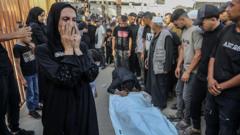In a tragic development amid ongoing tensions in Gaza, the International Committee of the Red Cross (ICRC) has reported that at least 21 people were pronounced dead upon arrival at its field hospital in Rafah following a "mass casualty influx". Many more individuals, including women and children, were among the 179 admitted with injuries, primarily from gunshot wounds or shrapnel. The sudden surge in casualties occurred during an aid distribution event, where conflicting narratives surrounding the event have emerged.
The Hamas-controlled civil defense agency in Gaza claimed that at least 31 people died in the incident, attributing the violence to "Israeli gunfire" targeting civilians. In contrast, the Israeli Defense Forces (IDF) asserted that their initial probe found no evidence to support claims that their forces fired at the civilians near the aid distribution center. They further released drone footage which purportedly showed armed individuals throwing stones and firing at civilians in the nearby city of Khan Younis while they gathered aid.
The credibility of these accounts is complicated by the restrictions imposed on independent media in Gaza, including a ban on international organizations like the BBC. Therefore, verifying the facts surrounding the incident has proven difficult. The Gaza Humanitarian Foundation (GHF), responsible for managing the aid distribution site, rejected claims of the incident's existence, suggesting that they were propagated by Hamas.
The ICRC's assertion highlighted that the incident marked the highest number of weapon-related injuries in a single day since the establishment of the field hospital over a year ago, with facilities overwhelmed beyond their capacity of 60 beds. Médecins Sans Frontières (MSF) also provided assistance and noted that the blood bank at Nasser Hospital was critically low, with staff donating blood to help treat patients.
As reports continue to emerge, it remains unclear whether the casualties reported by the ICRC and those of the Hamas health ministry correspond to the same incidents. Local sources indicated that more than 200 people arrived at medical facilities with injuries, while the Israeli military insisted that their troops did not engage with civilians.
Eyewitness accounts described chaotic scenes with wounded individuals being transported on donkey carts to hospitals due to delays in access for rescue crews, illustrating the dire humanitarian crisis faced by civilians in Rafah amid the ongoing conflict. However, IDF sources indicated that soldiers had fired shots near the crowd but did not intentionally target them.
The current situation in Gaza highlights escalating humanitarian challenges, exacerbated by limited aid access due to military operations and rising tensions between Israel and Hamas. As the conflict continues since the onset of Israel's military response following the October 7 attack by Hamas, casualty figures have surged, with estimates indicating that more than 54,000 deaths have occurred in Gaza.
The Hamas-controlled civil defense agency in Gaza claimed that at least 31 people died in the incident, attributing the violence to "Israeli gunfire" targeting civilians. In contrast, the Israeli Defense Forces (IDF) asserted that their initial probe found no evidence to support claims that their forces fired at the civilians near the aid distribution center. They further released drone footage which purportedly showed armed individuals throwing stones and firing at civilians in the nearby city of Khan Younis while they gathered aid.
The credibility of these accounts is complicated by the restrictions imposed on independent media in Gaza, including a ban on international organizations like the BBC. Therefore, verifying the facts surrounding the incident has proven difficult. The Gaza Humanitarian Foundation (GHF), responsible for managing the aid distribution site, rejected claims of the incident's existence, suggesting that they were propagated by Hamas.
The ICRC's assertion highlighted that the incident marked the highest number of weapon-related injuries in a single day since the establishment of the field hospital over a year ago, with facilities overwhelmed beyond their capacity of 60 beds. Médecins Sans Frontières (MSF) also provided assistance and noted that the blood bank at Nasser Hospital was critically low, with staff donating blood to help treat patients.
As reports continue to emerge, it remains unclear whether the casualties reported by the ICRC and those of the Hamas health ministry correspond to the same incidents. Local sources indicated that more than 200 people arrived at medical facilities with injuries, while the Israeli military insisted that their troops did not engage with civilians.
Eyewitness accounts described chaotic scenes with wounded individuals being transported on donkey carts to hospitals due to delays in access for rescue crews, illustrating the dire humanitarian crisis faced by civilians in Rafah amid the ongoing conflict. However, IDF sources indicated that soldiers had fired shots near the crowd but did not intentionally target them.
The current situation in Gaza highlights escalating humanitarian challenges, exacerbated by limited aid access due to military operations and rising tensions between Israel and Hamas. As the conflict continues since the onset of Israel's military response following the October 7 attack by Hamas, casualty figures have surged, with estimates indicating that more than 54,000 deaths have occurred in Gaza.


















